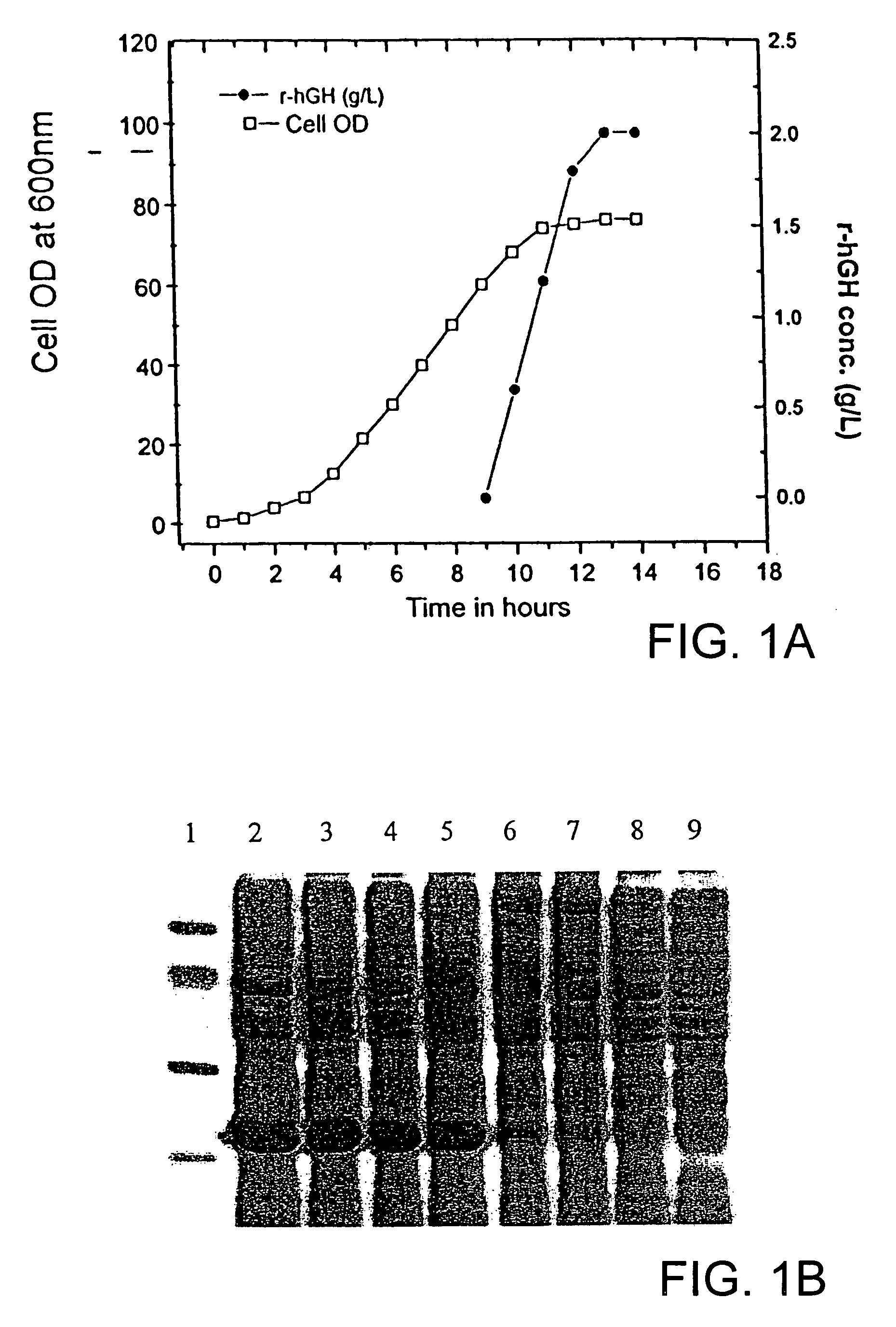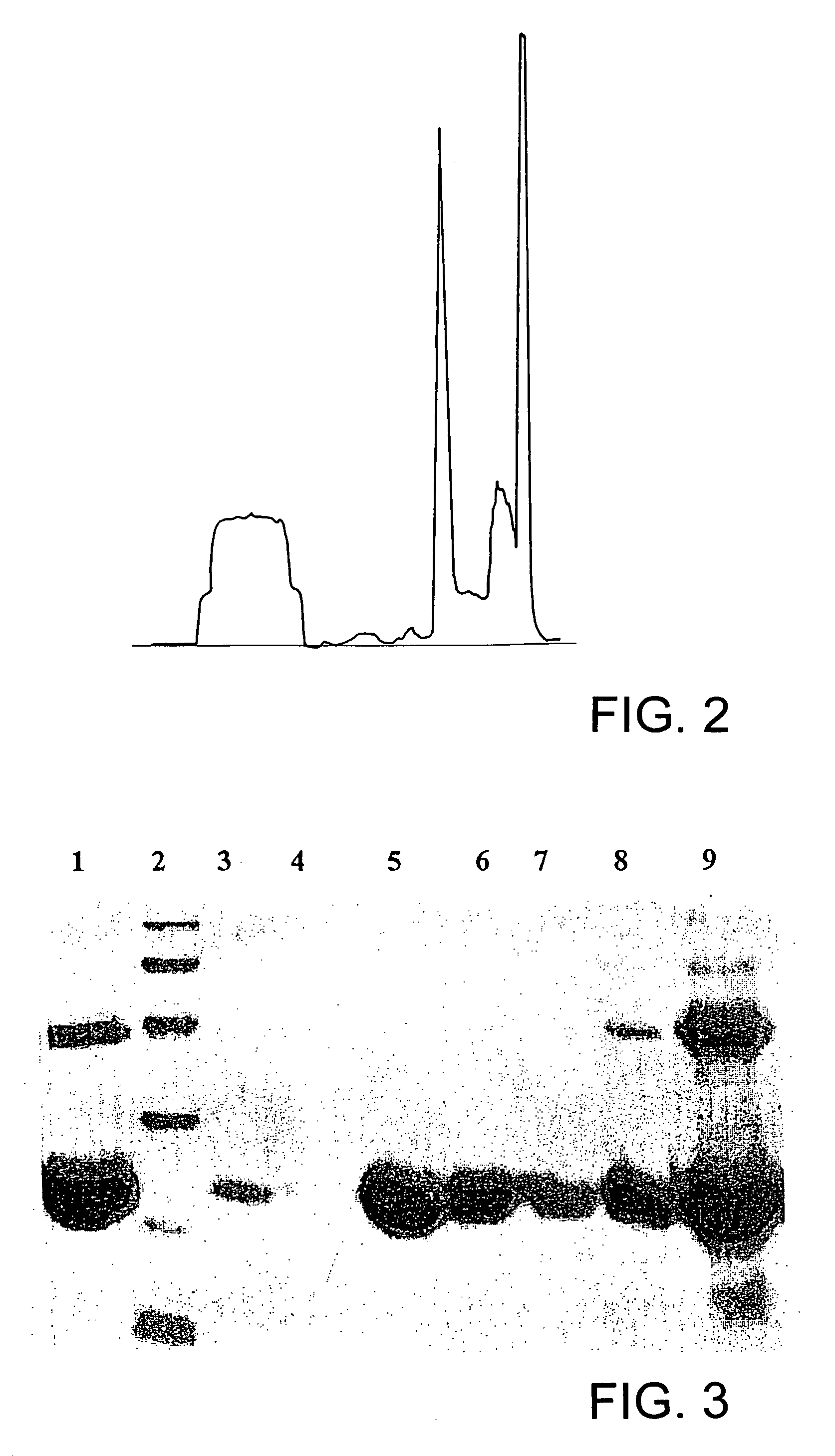Process for solubilization of recombinant proteins expressed as inclusion body
a technology of recombinant proteins and solubilization process, which is applied in the direction of lyase, growth hormone, transferase, etc., can solve the problems of large cost in the overall production of recombinant proteins, low final product recovery, and inability to fully recover, etc., and achieve high yield
- Summary
- Abstract
- Description
- Claims
- Application Information
AI Technical Summary
Benefits of technology
Problems solved by technology
Method used
Image
Examples
example 1
Improved Recovery of Recombinant Human Growth Hormone From Inclusion Bodies of E. coli
[0028]Human growth hormone (hGH), a single chain polypeptide containing 191 amino acid residues, apart from stimulating cell growth, plays an important role in variety of metabolic, physiologic and anatomic processes. The protein folds into a four-helix bundle structure with two disulfide bridges, one connecting distant parts of the molecule involving 53rd and 165th amino acid residues (large loop) and another between residues 182nd and 189th (small loop). Large scale requirement of r-hGH necessitates its high level expression in E. coli as inclusion bodies. However, expression of the protein along with fusion tag and subsequent use of high concentration of chaotropic reagents for solubilization and purification makes the overall process more complex and expensive as they lowers the yield of bioactive r-hGH. Recovery of recombinant human growth hormone from inclusion bodies by solubilization at al...
example 2
[0050]Enolse expressed as inclusion bodies in E. coli was solubilized and refolded in to bioactive form using this method. Fed-batch fermentation of E. coli resulted in production of 1 g / L of recombinant enolase as inclusion bodies. The denatured recombinant enolase in the form of inclusion bodies were isolated and purified from the cell by lysis and centrifugation. The inclusion body pellet was dissolved in 6 M β-Mercaptoethanol in presence 2 M urea solution. The solubilized enolase was separated by high speed centrifuge. Solubulized protein was dialysed in presence of 2 M urea to remove β-Mercaptoethanol. The protein was then recovered by conventional methods.
example 3
[0051]Polyketide synthase (PKS) of Mycobacterium tuberculosis was expressed as inclusion bodies in E. coli. The recombinant PKS was solubilized and refolded in to bioactive form using this method. Fed-batch fermentation of E. coli resulted in production of 2 g / L of recombinant PKS as inclusion bodies. The denatured recombinant PKS in the form of inclusion bodies were isolated and purified from the cell by lysis and centrifugation. He inclusion body pellet was dissolved in 6 M β-Mercaptoethanol in presence 2 M urea solution. The solubilized recombinant PKS was separated by high speed centrifuge. Solubulized protein was dialysed in presence of 2 M urea to remove β-Mercaptoethanol. The protein was then recovered by conventional methods.
[0052]Similar solubilization protocol was using β-mercaptoethanol with low molar urea has been successfully used for the solubilization of proteins aggregates formed during high level expression of recombinant proteins. Examples of proteins solubilized a...
PUM
| Property | Measurement | Unit |
|---|---|---|
| pH | aaaaa | aaaaa |
| concentration | aaaaa | aaaaa |
| temperature | aaaaa | aaaaa |
Abstract
Description
Claims
Application Information
 Login to View More
Login to View More - R&D
- Intellectual Property
- Life Sciences
- Materials
- Tech Scout
- Unparalleled Data Quality
- Higher Quality Content
- 60% Fewer Hallucinations
Browse by: Latest US Patents, China's latest patents, Technical Efficacy Thesaurus, Application Domain, Technology Topic, Popular Technical Reports.
© 2025 PatSnap. All rights reserved.Legal|Privacy policy|Modern Slavery Act Transparency Statement|Sitemap|About US| Contact US: help@patsnap.com



